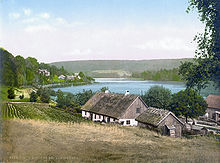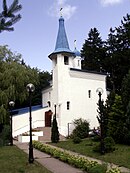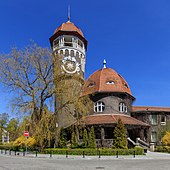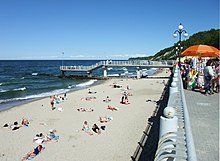Svetlogorsk
| city
Svetlogorsk
Rauschen Svetlogorsk
|
||||||||||||||||||||||||||||||||||||||||||
|
||||||||||||||||||||||||||||||||||||||||||
|
||||||||||||||||||||||||||||||||||||||||||
| List of cities in Russia | ||||||||||||||||||||||||||||||||||||||||||
Swetlogorsk ( Russian Светлогорск , literally translatable as "City on the bright mountain or city on the bright mountains"; old German name: Rauschen , Polish Ruszowice , Lithuanian Raušiai ) is a town and a seaside resort on the Samland Baltic coast in the Russian Kaliningrad Oblast . Svetlogorsk is the administrative center of the city circle Swetlogorsk in svetlogorsky district . The city has 10,772 inhabitants (as of October 14, 2010). Until 1945 the place belonged to the German Empire.
Geographical location
The seaside resort on the Baltic Sea is located in the historic East Prussia region , about 35 kilometers northwest of Königsberg ( Kaliningrad ).
history
Rauschen was mentioned in a document in 1258 as a Rusemoter in the diocese of Warmia. (1458 Rawschen, Rawssche; 1624 Rauschen). The name is Prussian and describes the shape of the coast hollowed out by the water ( ruset : flow slowly; rausis : excavated cave; moter : swampy land, area, riding). The settlement Rusemoter was probably located where the south bank of the mill pond extends today.
The mill pond itself was only created later under the rule of the Teutonic Order . These dammed the Katzbach in order to operate a water mill on the northeast bank of the mill pond that was created in this way . This mill was the largest in the Samland . Nothing is left of the mill, but there is still a 400-year-old linden tree on the eastern shore of the lake. Alt-noise was created at its edge .

Rausch's rise as a renowned seaside resort began with the construction of the Samland Railway . First, the Rauschen-Ort train station was built in 1900 . Six years later, the district of Rauschen-Düne , located directly by the sea, was also connected with its own train station. Even back then, bathers could take a cable car directly from the train station down to the beach. The cable car operated today no longer dates from this time. This cable car was modernized in summer 2014. The price for one trip is 25 rubles , children up to five years of age travel for free (as of July 2014).
The rural community of Rauschen belonged to the Neukuhren district from 1874 . In 1901 the rural communities Rauschen, Cobjeiten (Kobjeiten) and Sassau were merged while retaining the name Rauschen ; from 1910 the rural community Rauschen was spun off into an independent administrative district.
Until 1945 Rauschen was a well-known seaside resort and local recreation area for the residents of the city of Königsberg (Prussia) . In comparison to other places in East Prussia, Rauschen was only very little destroyed during the war, which is why a lot of historical building fabric from the 19th and early 20th centuries has been preserved here to this day. After 1945 the German residents who had not yet fled were expelled, mainly Russians and Belarusians were settled.
In June 1947, Rauschen was renamed Svetlogorsk and at the same time declared a city. In July 1947 the neighboring town of Otradnoje (Georgenswalde) was attached to Svetlogorsk. At this point the city became rajon-free. At times the places Jantarny and Pionerski were administered from Svetlogorsk. In 2007 Svetlogorsk became the seat of Svetlogorsk Raion .
The airplane accident of May 16, 1972
On May 16, 1972 at around 12:30 p.m., a Soviet military transport aircraft of the Antonov An-24T type collided with a tree on the cliff and fell 200 meters further on to a kindergarten, which also caught fire due to the jet fuel. The accident killed 35 people, including 24 children between the ages of two and seven, three kindergarten employees and the eight flight passengers.
The causes of the accident have not yet been clarified beyond doubt. It is assumed that the flight, which took off from Khrabrovo Airport , after a Swedish private plane had landed at the military airport in Kaliningrad- Chkalovsk a few weeks earlier , was intended to be used to check the radar surveillance and to be carried out at the lowest possible altitude. Fog is said to have prevailed over the Baltic Sea and the aircraft's altimeter worked incorrectly.
The public authorities tried to keep the incident as secret as possible. Rail traffic to and from Svetlogorsk was suspended and car traffic was controlled. The rubble of the kindergarten is said to have been cleared up the next day and a green area was set up in its place. Nevertheless, several thousand people came together at the funeral.
Population development
| year | Residents |
|---|---|
| 1933 | 2,178 |
| 1939 | 2,544 |
| 1959 | 6,726 |
| 1970 | 7,797 |
| 1979 | 9,982 |
| 1989 | 11,881 |
| 2002 | 10,950 |
| 2010 | 10,772 |
Note: census data
Districts
In addition to the town center, Svetlogorsk has the following eight districts:
| Place name | German name | Time of incorporation |
Remarks |
|---|---|---|---|
| Bobrowka (Бобровка) | Battau | before 1975 | Prussian Battau, Russian Dobroje , was also part of Svetlogorsk for a time and now belongs to the city of Pionerski . |
| Yuzhny (Южный) | Alexwangen | before 1975 | |
| Maiski (Майский) | Schönwalde | 1947? | |
| Otradnoye (Отрадное) | Georgenswalde | 1947 | |
| Prigorodnoye (Пригородное) | Kirti tendons | 1928 | |
| Zarechny (Заречный) | Sassau | 1901 | |
| Selski (Сельский) | Kobjeiten near Sankt Lorenz | 1901 | |
| Sori (Зори) | Tykrehnen | 1947? |
Churches
There are churches in Svetlogorsk
- Church of St. Seraphim von Sarow , built in 1907 as a Protestant church according to plans by Otto Walter Kuckuck and Ernst (?) Wichmann, Orthodox church since 1991
- Church of the Icon of Our Lady "Joy of All Sufferers", built in 1944 to commemorate the 1972 plane crash
Other former chapels are used culturally
- former Catholic Church Maria Meeresstern, built in 1930/31 according to plans by a former government architect D. Wilhelm Kleppe, since 1995 Makarow organ hall with an organ by Hugo Mayer (II / P, 24), the third largest in the oblast after those in Königsberg Cathedral
- Former Baptist chapel, built in 1905 in Rauschen-Ort according to plans by the community leader Karl Glauss, since 2007 the children's art school's concert hall
The nearest Protestant parishes are in Zelenogradsk (Cranz) and Kaliningrad (Koenigsberg) in the Kaliningrad Provostry .
traffic
rails
Svetlogorsk is directly connected to Kaliningrad via the Kaliningrad – Svetlogorsk railway. There is also an indirect connection via Zelenogradsk via the Kaliningrad – Zelenogradsk – Primorsk railway . There are two train stations: Svetlogorsk I (formerly: Rauschen-Ort) is the main train station for the village and used to be a through station for trains to Jantarny in the west. Swetlogorsk II (formerly: Rauschen-Düne) is a terminus especially for bathers with direct access to the beach. The route is electrified and powered by railcars. The journey time to Kaliningrad is 60 minutes with a direct connection and around 80 minutes with connections via Zelenogradsk.
Streets
Since 2011 there has been a connection to the Primorskoje Kolzo (coastal motorway ring), which ensures faster connections to Kaliningrad Airport and the Oblast capital. The district, which is close to the sea, is largely traffic-calmed.
Cable car
Since 1910 there have been community-owned cable cars from the high place down to the beach. After the shutdown, a bulky elevator tower was built, which was available to the spa guests of the military sanatorium and could be used by tourists for a tip. The plant was out of service for a few years and then was demolished. A new building is planned. The view of the Svetlogorsk coast extended from the elevator entrance.
The new cable car was built a few meters west of the elevator tower in Soviet times . This was also out of service for a few years and was renewed until 2014.
Culture and sights
In Svetlogorsk, extensive structures from the 19th and early 20th centuries have been preserved, especially in the style of seaside resort architecture typical of the Baltic Sea, which, in addition to newly built holiday villas and hotels, characterizes the townscape. The city's landmark is a water tower from German times, which today houses a warm bath together with the neighboring building. The water tower is adorned with the striking sundial by the Svetlogorsk artist Nikolai Frolow . The Warmbad with the characteristic tower was depicted on a 16-kopek postage stamp in 1967. Since this year at the latest, Svetlogorsk has been known as the " Sochi of the North" and is popular as a seaside resort in Russia.
The main attraction is and remains the sandy Baltic Sea beach, which has been attracting streams of tourists and spa guests to the town since the 19th century. Tens of thousands of visitors visit Svetlogorsk Beach every day. Around 70,000 spa guests visit one of the resort's spa businesses every year. The largest health resorts include Jantarny Bereg, the military sanatorium (former health resort) and "Swetlogorsk" (former Hartmann Hotel).

In Swetlogorsk there is an art museum with sculptures by the German sculptor Hermann Brachert , of which several large sculptures can also be seen in the open air. The church, built in 1907, is now used as a museum.
In 2008 it was decided to build a new theater in Svetlogorsk with a capacity of 1,600 people. Construction began in 2009, but was frozen a year later due to the global financial and economic crisis . Construction work resumed in October 2012. The first hall was completed in June 2015. On June 13, 2015 , the first event was held in the theater called Jantar Choll (ru. Янтарь Холл).
See also
literature
- August Eduard Preuss : Prussian country and folklore or description of Prussia. A manual for primary school teachers in the province of Prussia, as well as for all friends of the fatherland . Bornträger Brothers, Königsberg 1835, pp. 498–499.
- Roland Mischke: Königsberg East Prussia . 3rd edition Mairs geogr. Verlag, Ostfildern 2001, pp. 76-78. ISBN 3-89525-929-2
- R. Brückmann: Samland. A guide for hikers . Hartung, Königsberg 1926, Rautenberg, Leer 1989, pp. 54-70 (reprint). ISBN 3-7921-0385-0
Individual evidence
- ↑ a b Itogi Vserossijskoj perepisi naselenija 2010 goda. Kaliningradskaya oblastʹ. (Results of the 2010 all-Russian census. Kaliningrad Oblast.) Volume 1 , Table 4 (Download from the website of the Kaliningrad Oblast Territorial Organ of the Federal Service for State Statistics of the Russian Federation)
- ↑ Which possibly referred to the dunes of the Curonian Spit, as this name may have been confused with the name Zelenogradsk (city in the green) , which was ultimately taken for the place Cranz .
- ↑ District Neukuhren on territorial.de
- ↑ The Указ Президиума Верховного Совета РСФСР от 17 июня 1947 г. "Об образовании сельских советов, городов и рабочих поселков в Калининградской области" (Decree of the Presidium of the Supreme Soviet of the RSFSR of 17 June 1947: On the Formation of village Soviets, cities and workers' settlements in Kaliningrad Oblast)
- ↑ The place name Svetlogorsk should be confused with the place name Zelenogradsk chosen for the place Cranz .
- ↑ Through the Указ Президиума Верховного Совета РСФСР от 25 июля 1947 г. "Об административно-территориальном устройстве Калининградской области" (Decree of the Presidium of the Supreme Soviet of the RSFSR of July 25, 1947: Establishment of the Oblast-Kaliningrad)
- ↑ Valeri Gromak. “Трагедия, о которой молчали 30 лет” Pravda, May 16, 2006
- ↑ Igor Rudnikow: Черная икра для адмирала - «Новые колёса» . Retrieved March 4, 2016.
- ↑ Jewa Merkatschewa, Alexandr Burakov: Неизвестные факты о самой трагической авиакатастрофе в истории страны : падении самолета на детский сад , Московский комсомолец. 16 мая 2014. Retrieved March 4, 2016.
- ↑ Sacred buildings in Swetlogorsk Prussia 39, with photos and further links (in Russian)
- ↑ ( page no longer available , search in web archives )
- ↑ Barbara Wolf-Dahm: Catholic diaspora on the amber coast of Samland. In: Magazine for the history and archeology of Warmia. Volume 46, 1991. pp. 61-82, here p. 76f. PDF
- ↑ КВН на кубок губернатора впервые прошел в светлогорском «Янтарь-холле». In: Free Kaliningrad . June 14, 2015, accessed June 22, 2015 (Russian).
Web links
- Svetlogorsk photo gallery (German)











